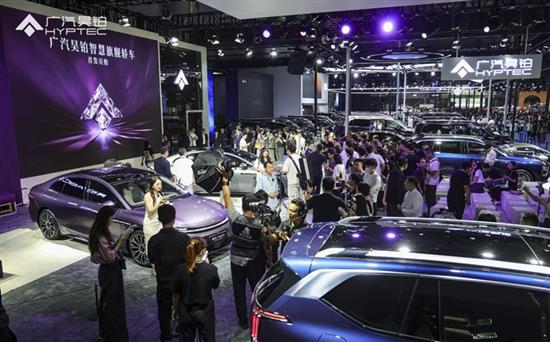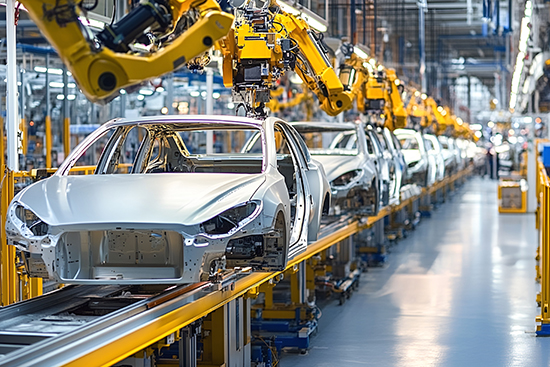Revaluing: China Auto Industry Enters a New Phase of Brand Competition
"The complex experiences of Luo Jia regarding her mother, biological father, and stepfather deeply moved me, but my own family history, my own experiences, surpass them in every way. It is a saga of blood and tears, a story of struggle, and a century-old legend," wrote novelist Zhang Wei in the novel "The River Bend." In a certain sense, the Chinese automotive industry is also experiencing its own historical river bend—from price wars to value return, from sales data to brand establishment.


Image Source: GAC Group Official Weibo
Before the National Day holiday, I led a group to GAC Group where I had in-depth exchanges with senior executives. In a conversation with my old friend, GAC Group Chairman and General Manager Feng Xingya, he provided a detailed introduction to the Huawei cooperation project, at a time when the "Qijing" brand had not yet been announced. "We will soon launch this new brand, which is completely different from the previous collaboration models like Avita or Huawei's 'Five Realms,'" Feng Xingya said. "In addition to our strong manufacturing capabilities, GAC will learn from Huawei in terms of product definition and brand marketing, allowing Huawei to take the lead. For GAC, this is a historical opportunity to reshape our brand marketing model in the face of market competition!" At that moment, I sensed the heavy weight of the word "brand" from our conversation.
If the shift from enterprise competition to brand competition is a proactive strategic choice, then the cessation of the internal price war is undoubtedly an important driving force for the market to prompt car companies to make changes.
During the National Day holiday in 2025, the automotive market experienced a subtle change: compared to previous years, car manufacturers' price reduction promotions weakened and covered a smaller scope. Under the influence of intensified "anti-involution" policies and the rebound of raw material prices such as lithium carbonate, the space for automakers to engage in a "price war" has further diminished. Meanwhile, the profits of industrial enterprises above a designated scale turned from a decline to an increase in the first eight months, with a profit growth rate of 20.4% in August alone. These two seemingly independent signals indicate that China's auto market is ushering in a historic transition from scale competition to brand competition.
Price war recedes: automakers reduce promotional efforts, industrial enterprises' profits rebound.
At the end of September, there was no widespread "price reduction promotion" that was commonly seen in previous years at car dealerships across regions. Instead, discounts on many popular car models were actually reduced. Data released by the China Automobile Dealers Association shows that the inventory warning index for Chinese car dealers in September was 54.5%, a decrease of 2.5 percentage points from the previous month, but still above the threshold line. The performance during the "golden September and silver October" period basically met expectations, but the price wars of previous years were no longer seen.

Cui Dongshu, Secretary-General of the China Passenger Car Association, believes that under the influence of multiple factors such as the intensification of "anti-involution" policies and the rebound in prices of raw materials like lithium carbonate, the room for car companies to engage in "price wars" has further diminished. On the policy front, there is guidance for the industry to shift from purely pursuing scale to focusing on quality and efficiency, which has prompted a change in the competitive approach of the automotive industry.
Meanwhile, the profits of industrial enterprises have significantly improved. According to data from the National Bureau of Statistics, the profits of industrial enterprises above a designated size increased by 0.9% year-on-year in the first eight months of this year, reversing the continuous decline in cumulative profits since May. The improvement in profits was even more pronounced in August, with a growth rate of 20.4%.
What is even more noteworthy is that in the first eight months, the profit margin of industrial enterprises above a designated size was 5.83%, an increase of 0.90 percentage points year-on-year. The recovery of corporate profitability provides a macroeconomic foundation for the cessation of the price war in the automotive industry. The China Association of Automobile Manufacturers also pointed out in a recent analysis report that the contribution of the automotive manufacturing upstream and downstream to the national economy's GDP is over 10%. The increase in industrial enterprises' profits due to reduced internal competition is most prominently reflected in the automotive industry.
Profit Redistribution: The Prominent Role of the Equipment Manufacturing Industry as a "Ballast"
In the context of improved profits for industrial enterprises overall, the "ballast" role of the equipment manufacturing industry is evident. In the first eight months, profits for equipment manufacturing enterprises above designated size grew by 7.2%, contributing to a 2.5 percentage point increase in the profits of all industrial enterprises above designated size. This data is fully reflected in the automotive industry chain.

The steel industry, as an important upstream sector of the automotive industry, has seen an overall rebound in profitability this year. According to the performance forecast of Shandong Iron and Steel, it is expected to achieve a total profit of approximately 632 million yuan in the first three quarters of 2025, an increase of about 2.196 billion yuan year-on-year. Similar situations have occurred in several steel companies such as Liuzhou Iron and Steel, Anyang Iron and Steel, and Xinyu Iron and Steel. According to data from the China Iron and Steel Association, the operating revenue of key steel companies in the first half of the year decreased by 5.79% year-on-year, but the total profit increased by 63.26% year-on-year. The decline in revenue but increase in profit reflects that the reduction in raw material prices was much greater than the decline in finished steel prices, creating conditions for improved profitability for listed steel companies.
From a decline in revenue to an increase in profits, the recovery of the steel industry mirrors the restoration of profitability in the automotive industry chain. This improvement in profits is gradually being transmitted downstream along the supply chain. A survey by the China Automobile Dealers Association shows that 44.4% of dealers are optimistic about the car market in the fourth quarter, predicting a year-on-year sales growth of 5% to 10%.
Brand Competition Rise: From Technology Accumulation to Brand Value Construction
As the price war subsides and technological homogenization becomes a new industry pain point, the importance of brand value is increasingly highlighted. In retrospect, the in-depth interview with GAC before the National Day and the collaboration case of Huawei's Qijiang should be a clear example of the current shift towards brand competition in the Chinese automotive market.
"Why should we only buy BBA for cars over 300,000 yuan?" This is the sharp question posed at the launch conference of the new brand "Qijing," a collaboration between GAC and Huawei. This new brand aims to break the monopoly of traditional luxury cars and capture a share of the high-end market over 300,000 yuan. The core of brand competition is shifting from "technology stacking" to user experience. In brand building, Qijing has chosen to make "safety" a fundamental skill. With a 192-line LiDAR and 4D millimeter wave radar, the detection range is twice that of the industry, and the false trigger rate is as low as the "hundreds of millions of kilometers" level.
More importantly, one of the rights for the first batch of Qijing owners is lifetime free upgrades for LiDAR firmware. This long-term service commitment surpasses the traditional one-time sales model, building a lasting connection between the brand and its users.
In the fiercely competitive new energy vehicle market, brand value no longer solely depends on product performance, but rather on the ability to establish a trust relationship with users. Users want to say "I trust you"—trust that you won't suddenly cut prices and betray them, trust that your intelligent driving is reliable enough to use with eyes closed, and trust that there will be support if something goes wrong.
Channel Transformation: Dealers' Aspiration for Service as Core Competitiveness
The arrival of the era of brand competition is also changing the ecosystem of car sales channels. A memorable scene from the Qijing Investment Promotion Conference was that the number of registered dealers was three times the expected amount, and they couldn't even add chairs in time. Behind this enthusiasm is the dealers' desire for brands that can provide sustained profitability.
GAC is responsible for making cars as durable as the Highlander, while Huawei is responsible for keeping the intelligent driving system as updated as a smartphone through OTA. Both manufacturers avoid acting high and mighty, with profit-sharing written directly into the contract, and for the first time, dealers feel that "selling domestic cars doesn't require kneeling." In stark contrast, some brand dealers are facing multiple pressures such as sluggish customer traffic growth, continued price inversions, and declining profitability. Insufficient customer traffic is the most common challenge, with a natural decline in walk-in customers and low conversion rates of online leads.
The China Automobile Dealers Association suggests that dealers should make rational estimates of actual market demand based on actual conditions, while also increasing the promotion of "trade-in and scrap renewal policies." By strengthening services to boost consumer confidence, they should prioritize cost reduction and efficiency improvement.
More importantly, service has become a core element of brand competition. According to reports, Qijing's display vehicles have not yet been launched, but after-sales training has already been scheduled until next March, and even tire-changing technicians are required to pass Huawei's intelligent driving theory exam. Such forward-thinking investment in service capabilities was unimaginable during the traditional price war era.
Future Outlook: Moderate Recovery in the Car Market in the Fourth Quarter with Continued Brand Differentiation
Looking ahead to the fourth quarter, Lang Xuehong, deputy secretary-general of the China Automobile Dealers Association, stated that despite some regions suspending automobile replacement and upgrade subsidy activities, the significant customer attraction effect during the double festival holidays and the concentrated release of travel and car purchase demand, combined with dealers’ year-end promotional activities, are expected to support a moderate rebound in monthly sales. According to the association's survey, 44.4% of dealers hold an optimistic outlook for the fourth quarter automotive market, predicting a year-on-year sales growth of 5%-10%.
According to the analysis from various research institutions, the industry is generally optimistic about the future market trends, with expectations for the automotive market in October to show a "high opening and steady performance" pattern. Supported by the traditional peak season pattern of "golden September and silver October," the continuation of subsidy policies in many regions, and the promotional effects of the National Day and Mid-Autumn Festival, along with a series of upcoming auto shows, the market traffic and sales are expected to receive a significant boost.
However, the market recovery is not universal, and brand differentiation will continue to intensify. The cooperation case between GAC and Huawei demonstrates that strong brand alliances will become an important form of competition in the future market. In Huawei's intelligent driving landscape, AITO has already captured a 22% share, while BYD holds a solid throne with a 35% share, leaving little room for other brands.
At the "bend of the river," there must be a turn. The Chinese automotive market is at a historical turning point, emerging from the quagmire of price wars and heading towards a new blue ocean of brand competition. Those companies that can first establish brand value and create an exceptional service experience will gain an advantage in the new round of competition.
【Copyright and Disclaimer】The above information is collected and organized by PlastMatch. The copyright belongs to the original author. This article is reprinted for the purpose of providing more information, and it does not imply that PlastMatch endorses the views expressed in the article or guarantees its accuracy. If there are any errors in the source attribution or if your legitimate rights have been infringed, please contact us, and we will promptly correct or remove the content. If other media, websites, or individuals use the aforementioned content, they must clearly indicate the original source and origin of the work and assume legal responsibility on their own.
Most Popular
-

List Released! Mexico Announces 50% Tariff On 1,371 China Product Categories
-

Nissan Cuts Production of New Leaf EV in Half Due to Battery Shortage
-

New Breakthrough in Domestic Adiponitrile! Observing the Rise of China's Nylon Industry Chain from Tianchen Qixiang's Production
-

Dow, Wanhua, Huntsman Intensively Raise Prices! Who Controls the Global MDI Prices?
-

Mexico officially imposes tariffs on 1,400 chinese products, with rates up to 50%






